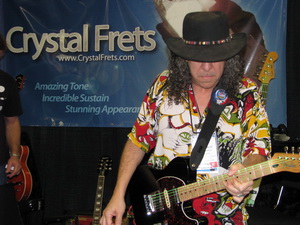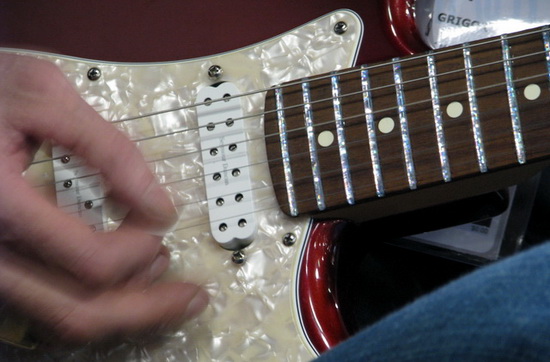| « Lovers of Music Invited to ‘Wanna Play Music Day’ at 2011 Summer NAMM | ArtistWorks and Their Innovative Online Music Education System » |
Ancient Rocks and Roll - BFMN Reviews Crystal Frets
One of the coolest things about attending a NAMM convention is that it is the ultimate venue for a new product debut. While there, you not only get to see what’s new, you actually get to play with it.
We found one of the most interesting innovations this year way in the back of Hall E, at the next-to-the-last booth. Crystal Frets was there with a fascinating idea. They have patented a process for making and installing frets made from 100% pure quartz crystals. They are definitely beautiful but we wanted to know if they really make a difference. The short answer is “Yes, apparently they do.” BFMN spent some time at their booth, hosted by none other than the tie-dyed Capn Flashback and the designer Erich Stone. We played all the guitars and shot Emilio Emilio performing for the video below. We had a great time and we’ll be doing more with these guys; they were a lot of fun and the very idea of Crystal Frets resonates with me.
Don’t fret, there’s more! Click through for the video!
Fretted instruments have been around for a really long time. Their purpose is obvious: they shorten the string in very specific increments, making the tone higher as you go up the neck. Traditional materials are still being used and, depending on who you talk to, there are good reasons for them all. Precision placement is required for accurate intonation. The math is important; the depth of the fret slot must match the length of the tang, leaving a hair’s breadth for wood expansion and contraction. The width of the wire, the height above the wood and the way the edges are finished all contribute to the “feel” and playability of the instrument and, of course, each fretted note’s tone includes the reaction of string on fret. How the material affects the tone is key to the Crystal Frets phenomenon.
The most common material for frets is Nickel Silver, which actually contains no silver at all but is an alloy made of copper with a dash of nickel and a dash of zinc. There is also a nickel-free version, commonly called “gold wire,” that uses the same proprietary alloy primarily used for eyeglass frames for folks who are allergic to nickel. A touch more durable and still easy to work with, it is considered by many to strike the balance between durability and cost. Stainless steel is another material used for its durability. Though a tad more expensive, stainless steel lasts longer, being more resistant to wear and corrosion. The longer wear advantage is offset by the fact that you need diamond-headed tools to cut it and no matter how hard you try, metal strings will still wear it down eventually. Crystal frets, on the other hand, are hypoallergenic and impervious both to corrosion and to wear by metal strings. A natural element, quartz crystal is the second most common mineral in the planet’s crust, but its unique density also demands diamond-headed tools in the milling process.
The height is important as well. Though it doesn’t affect the intonation, taller frets make clear tones easier to play with less finger pressure. You shouldn’t have to press the string down to the wood to get a clear tone. It just has to touch the fret, so a little height off the wood makes that easier. The “action” is measured from the top of the fret to the bottom of the string. That means you can still have really low action with taller frets. A well-balanced combination of those two things enhances an instrument’s “playablity.”
The metal-on-metal aspect of string-on-fret creates a natural distortion of tone. Listen to the difference of a string played open and the sound of the same note fretted. The open string note has a depth of tone not heard on the fretted note. The note lasts longer too. The fretted note sounds just a little muted and the sound fades more quickly.
Sustain is the holy grail of guitar sound and manufacturers choose their tone woods carefully. They shape braces in specific ways and add tone bars and arched tops and brass nuts and anything else they can think of in their endless search for sustain and depth or richness of tone. Many manufacturers, Guild Guitars for instance, specifically use bone nuts and saddles for added clarity and sustain. As they put it, “It transfers the energy of the string to the wood better than plastic.” I couldn’t agree more.
(See an explanation for the use of bone in the interview segment of BFMN’s review of the Guild F-412 twelve-string guitar)
Crystals resonate differently than metal, and the density of quartz crystals transfers the string’s energy in a different way. You may not know it, but crystals have been used for years in “piezoelectric pickups,” most commonly found in acoustic guitars and violins, which use piezoelectric crystals. These types of crystals actually generate a small amount of voltage when they vibrate. Using a piezo pickup under the saddle of a guitar produces a much more accurate amplification of the guitar tone. Transparently transferring the energy of the vibrating string through the saddle to the crystal in the pickup more accurately reflects the sound of the unamplified guitar than a magnetic pickup does. It sounds more like an acoustic guitar sounds. Amplifying an acoustic guitar always sounded a little too “electric” until piezo pickups came along.
Enter Erich Stone. There isn’t much you can do to a guitar that hasn’t been done. This wood or that wood, these pickups or those; there’s nothing new under the sun. A few years ago, when Erich decided he wanted to earn some extra money to visit his girlfriend overseas, he chose decorating guitars as a possibility. He shared the idea with her and she suggested glass as a material. He went right past that to crystals without even thinking of sound enhancement, simply wanting to improve the beauty of the guitar without destroying the sound. After the first conversion – an off-the-rack Strat – sound became a priority. He says, in fact, that as soon as he got the very first fret installed and played a few notes he knew he was onto something. A little research and a lot of money later, he is perfecting the installation of frets made out of 100% Quartz Crystal and turning the heads of guitar players around the world.
A bit skeptical, I played one at the NAMM Show this year and I was really surprised at how playable they were as well as how beautiful they are. They look cool, catching the lights, changing colors; they really came alive when you played and the increased sustain was notable even from the really loud convention floor. Ideal for use with effects, and clear as a bell without, they really surprised me. After talking with Erich and learning why they sounded so good, it kind of makes sense. The first new guitar for the 21st century - wouldn’t you know it uses rocks that have been around since the Earth was formed. Add in the ever-controversial mystical qualities of crystals and vibrations and some say, “It gives the guitar a soul.”
We’ll be bringing you more from Crystal Frets; it’s too good a story for a single post! In the meantime, check out their website and contact Emilio for a quote on giving your guitar the gift of stunning sustain.




